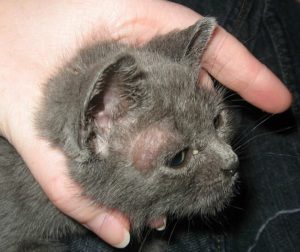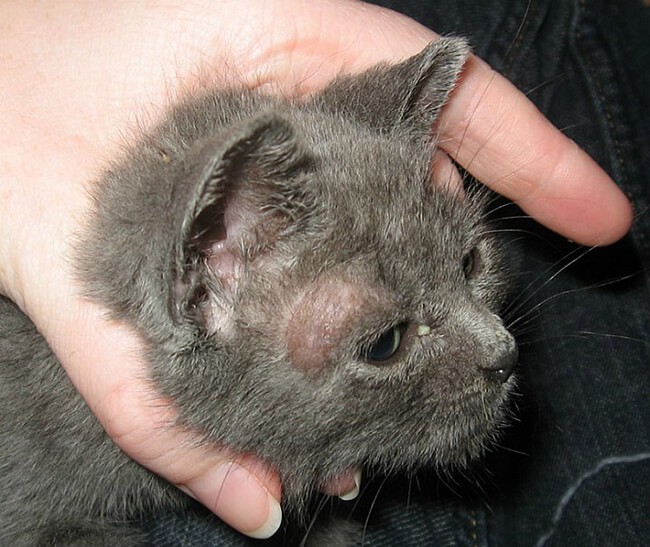If your cat is constantly scratching their ears, shaking their head, or has a buildup of crust or scabs in their ear canal, they may be suffering from ear mange. Ear mange, also known as otodectes cynotis, is a common parasitic infection that can cause discomfort and irritation in cats. Fortunately, there are ways to easily treat this condition and relieve your feline friend’s discomfort. In this article, we’ll explore the secret to easily treating cat ear mange, including its causes, symptoms, and treatment options.

Easily Treating Cat Ear Mange
Cat owners who suspect their pet may have ear mange can greatly benefit from learning how to easily treat this condition. Identifying the symptoms early on and seeking prompt treatment can help prevent the infection from worsening and affecting other areas of the body. Additionally, knowing how to effectively treat ear mange can save you time and money from repeated visits to the vet.
What is Ear Mange?
Ear mange is a common parasitic infection caused by microscopic mites that live in a cat’s ear canal. These mites feed on the wax and oils found in the ear and can cause irritation and inflammation. Symptoms of ear mange include excessive scratching, head shaking, and a build-up of crust or scabs in the ear canal. If left untreated, ear mange can lead to more serious health issues such as bacterial infections and hearing loss.
Causes of Ear Mange
Ear mange is usually caused by contact with an infected animal, such as another cat or a dog. The mites that cause the infection can survive for several days outside of a host, so it’s important to thoroughly clean any bedding or areas where your cat spends time if you suspect they have ear mange. Additionally, cats with weakened immune systems or poor hygiene are more susceptible to developing ear mange.
How to Easily Treat Cat Ear Mange

There are several effective treatment options for ear mange that can easily be administered at home. Here are some ways to easily treat cat ear mange:
1. Clean your cat’s ears
The first step in treating ear mange is to clean your cat’s ears. Use a gentle cleanser designed specifically for cats, and gently wipe the inside of the ear with a soft cloth or cotton ball. Be sure to avoid using Q-tips or anything that may damage the ear canal. Cleaning your cat’s ears can help remove any debris or build-up that may be contributing to the infection.
2. Apply medication
Once your cat’s ears are clean, apply a medication that is specifically designed to treat ear mange. These medications typically contain an insecticide that kills the mites causing the infection. Follow the instructions provided with the product carefully, and be sure to administer the medication directly into the ear canal as directed.
3. Repeat treatment
In most cases, it will be necessary to repeat the medication treatment several times over the course of several weeks to fully eliminate the mites causing the infection. Follow the instructions provided with the product carefully, and be sure to administer the medication as directed.
Pros and Cons of Treating Cat Ear Mange at Home
While there are benefits to treating cat ear mange at home, there are also some potential drawbacks to consider. Here are some pros and cons of treating cat ear mange at home:
Pros
- Cost-effective: Treating ear mange at home can save you money on repeated trips to the vet.
- Convenience: You can treat your cat’s ear mange at home on your own schedule, without having to make appointments with a vet.
- Early intervention: Treating ear mange at home can help catch the infection early on and prevent it from spreading to other areas of the body.
Cons
- Potential for misdiagnosis: Without a professional diagnosis, there is a risk of misdiagnosing the condition and administering the wrong treatment.
- Risk of injury: Administering medication to your cat’s ears can be challenging, and may result in injury if not done properly.
- Ineffective treatment: If the infection is severe or has progressed too far, home treatment may not be effective and more intensive veterinary care may be necessary.
Alternatives to Treating Cat Ear Mange at Home

If you’re hesitant about treating cat ear mange at home, there are several alternative options to consider. Here are some alternatives to home treatment:
1. Veterinary care
Seeking veterinary care is always an option when it comes to treating ear mange. A veterinarian can provide a professional diagnosis and prescribe medication that is tailored specifically to your cat’s needs. Additionally, a vet can monitor your cat’s progress and adjust their treatment plan as necessary.
2. Natural remedies
There are several natural remedies that can help soothe your cat’s ear mange symptoms, such as tea tree oil or coconut oil. However, it’s important to notethat natural remedies have not been extensively studied for their efficacy in treating ear mange and may not be as effective as prescribed medication.
3. Ear flush
An ear flush is a veterinary procedure that involves flushing the ear canal with a solution to remove debris and mites. This can be an effective alternative to home treatment, especially if the infection is severe or has spread to other areas of the body.
Step-by-Step Guide to Easily Treating Cat Ear Mange at Home
If you’ve decided to treat your cat’s ear mange at home, here’s a step-by-step guide to help you through the process:
Step 1: Clean your cat’s ears
Use a gentle cleanser designed specifically for cats, and gently wipe the inside of the ear with a soft cloth or cotton ball. Be sure to avoid using Q-tips or anything that may damage the ear canal.
Step 2: Apply medication
Apply a medication that is specifically designed to treat ear mange. These medications typically contain an insecticide that kills the mites causing the infection. Follow the instructions provided with the product carefully, and be sure to administer the medication directly into the ear canal as directed.
Step 3: Repeat treatment
In most cases, it will be necessary to repeat the medication treatment several times over the course of several weeks to fully eliminate the mites causing the infection. Follow the instructions provided with the product carefully, and be sure to administer the medication as directed.
Tips for Easily Treating Cat Ear Mange
Here are some additional tips to make treating cat ear mange at home easier:
- Use a gentle touch when cleaning your cat’s ears to prevent injury.
- Administer medication slowly and steadily to prevent discomfort or injury.
- Use treats or rewards to help make the process more pleasant for your cat.
- Keep your cat’s bedding and living area clean to prevent re-infection.
- Monitor your cat’s progress and seek veterinary care if symptoms persist or worsen.
Conclusion
Treating cat ear mange doesn’t have to be a complicated or stressful process. By identifying the symptoms early on and learning how to easily treat the infection at home, you can help relieve your feline friend’s discomfort and prevent the infection from spreading. Whether you choose to treat ear mange at home or seek professional veterinary care, always prioritize your cat’s health and well-being.
